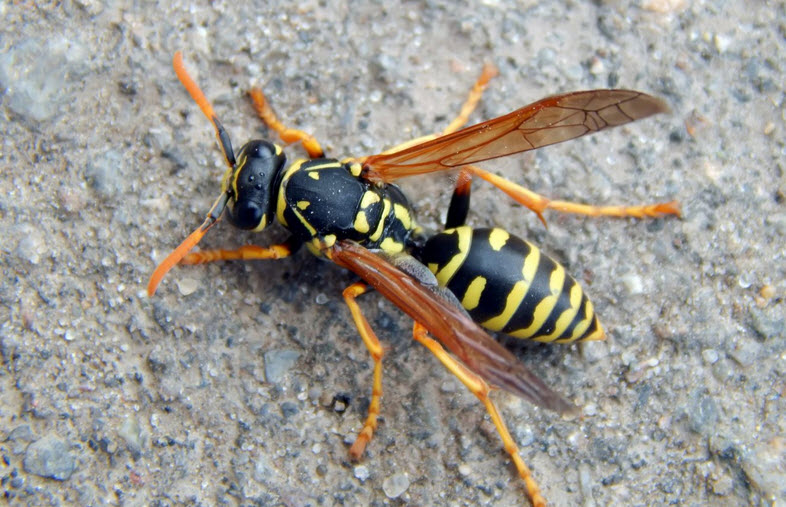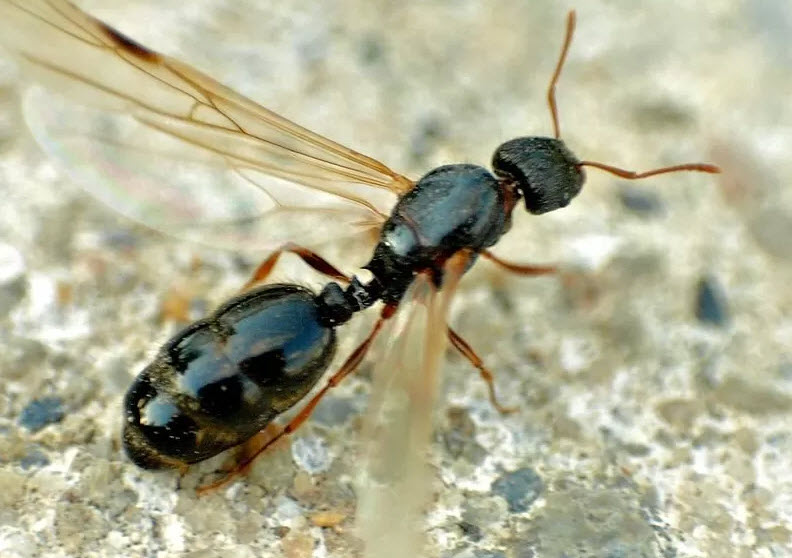We can learn a lot from every living thing… even bugs.
I
Conversations with a Bug
I’m sitting on the northeast bluff of Wee Bear, my soul soaring among the purple cliffs and diving down to the distant, dwarf-like trees in the valley… Channeling free-form thoughts from the pure mountain atmosphere into in a rumpled spiral notebook…
There is nothing superfluous in the natural world. Everything has a purpose, and nothing is wasted. By contrast, you could take 99% of the meaningless junk that is so passionately pursued and guarded jealously (often violently) by humankind; and if you could eliminate it all at once – and the memory of it as well – the world would be a much better place…
Click-clack… flip. Click-clack… flip.
Something persistently distracts my peripheral vision and hearing. It is an ant-like insect with wings, which has periodically been making a light, abrupt clattering sound on the white granite platform where I am seated.
“How can a guy write here with such a racket?” My thoughts dissipate with vexation, “I’m trying to write inspiring prose to awaken humanity to its ultimate purpose…”
As my attention shifts to this niggling little creature, I watch for the source of its insistent rattle. It has long, clumsy-looking wings three times the length of its body, which are trembling with frustrated ambition. This bug has been trying to use its new wings for some time now, and each time it takes off, it flips on its back with a comic pratfall and bonks its head on the rock, as if it had stepped on a miniature banana peel.
“Duh,” I snort sanctimoniously, “The stupid bug can’t even use its own wings!”
“Hey, shaddup! I’m tryin’ to fly, over here!” Surprisingly, the bug answers me! Even more surprising, it has the Saturday morning cartoon voice of Mel Blanc.
More than suddenly, like the non-time-consuming communication of trees or the metaphysical telepathy of quarks, a new thought is beamed down to my medullar antennae. As this new thought takes tremulous form, it seems to be rushing at me with the wind from across the valley; gathering strength as it surges up through the treetops and funneled by the cliffs. This realization comes in a flutter of angel wings and softly lands in my head like a snowflake: I don’t know how to use my wings, either.
Click-clack… flip. Click-clack… flip.
It is lovingly reminded to me that all of us are born with the wings of epiphany – our tragedy is that, not knowing how to use them, we wind up flat on our backs time after time. Like this intrepidly annoying insect that tries and tries again, I have many times glimpsed my higher purpose in life, only to clumsily collapse on takeoff. How many times has this bug tried to fly since I’ve been watching? Fifty? A hundred? How many times have I really tried to fly with the angels? Not enough to succeed.
“You had enough yet, you stupid bug?”
“Aw, go jump in the lake!”
At last the discouraged little ant-like creature stalks away, resigned to his pedestrian fate, and he’s probably blaming the quality of the wings. I should be so ignorant. I know my wings are of the highest quality, and yet I have not summoned enough courage to keep on trying, especially after I bonk my head repeatedly. Like this miserable bug (and most of the miserable human race) I have resigned myself to forget that I have any wings at all, and weigh myself down with false pretensions to assuage my ego as I try inadequately to make some purposeful progress. The reality of grace mocks my inadequacy.
I get one last glimpse of the bug still plodding desperately towards something other than its intended purpose.
“Have a nice life,” I call out sardonically.
“Kiss my ass, Doc!” says the bug, as his pointless wings disappear from view over the edge of the rock. Golly, that doesn’t sound like Bugs Bunny at all!

II
Buried at the Bottom of the Hourglass
Yellow jacket wasps are a persistent and remarkable pest when enjoying the great outdoors. Science calls them Vespula squamosa, which sounds like a noisy Italian scooter, and they are just as irritating. I first learned how annoying they are during my family’s car camping forays in the 70’s. We killed thousands of the pests, due to their unrelenting desire for food to bring back to their nest, and their callous disregard for whoever its owner might be. They madly weave back and forth in the air to avoid being hit by rolled-up newspapers, baseball caps, spatulas, and other typical camping weapons. When one lands, it precisely carves off a chunk of bacon, hamburger, chicken, hot dog, or steak, calculated to be the maximum weight it can carry back to the nest. The protein-rich contraband is transported deep into the bowels of the forest floor to be devoured by corpulent, pulsating larvae. Multitudinous cycles of yellow jacket metamorphoses are fed by the store-bought smorgasbord delivered by humans; especially when they have a picnic or barbecue. The more humans supply food; the more yellow jackets will propagate.
This natural balance can be seen in suburban backyards as well as the deep woods. Yellow jackets proliferate in direct ratio to the available food in the area. Each newly-hatched worker dries its wings and takes off immediately in search of more protein. Your skin crawls when they swerve around your plate, because you know they would just as soon carve off a hunk of your living flesh if you weren’t paying attention. They are hard to kill in the air, but it is a simple matter to wipe them out one by one when they reach their target. They land on your food like they own it. Whack!!! Sometimes, their distressed, writhing bodies attract more yellow jackets, who carry them back to the nest as part of a grisly recycling program. Their obsession for food is easily demonstrated by the garish, plastic bag wasp traps that rapidly fill up with the ravenous little pests, using only a smell as bait. They greedily seek and devour any protein within a proprietary radius of their nest. Meanwhile, back at headquarters, the mutant queen ceaselessly pumps out diabolical little eggs that hatch into voracious larvae. These are fed by the scavenger adults, who die to raise a new generation to feed more larvae, and on and on. If your hamburger wasn’t so tantalizingly available, they would rid the surrounding area of carrion and other insects, which actually helps the forest and its animal life (including us).
Vespula specimens will rarely sting except in defense of their nest. Once, while backpacking up the Bear Creek trail, I walked right past a yellow jacket nest and got stung hard, but not as badly as I could have. The nest was in an area of the trail where ash gray rocks nestled deep in the fine layered dust of the trail, sticking out like gigantic golf balls that had plopped into a sand trap. I was walking fast to get out of the sun as quickly as possible, and I saw the little banded hell hounds boiling from a hole in the ground under one of the rocks as I passed. Maddened by the ground vibrations of my passing, they exploded through the air like yellow and black fireworks, searching for the intruder. I almost got away. Five or six paces from the nest, I got nailed once on my calf muscle. The venom hit like a hammer, but I stumbled forward in shock, half running with my pack on, to escape being stung again.
My skin was angry red and white when I stopped at a safe distance to wash it briskly and cool down the fire, but I felt compelled to move on. No telling when the wasp hoards would find me. Vivid memories contributed to my alacrity. When I was a toddler, I was stung multiple times after knocking a wasps’ nest in a tree with a pole, mistaking it for a pear. Perhaps I was sensitized by the amount of venom at such an early age, but now any wasp sting feels much more painful than it probably should. As I hiked onward, my calf began to throb and ache, radiating up to my hamstring. I reasoned glumly that the intense workout for that muscle was exacerbating the spread of the toxin and my pain response. By the time I reached my destination, an area on my calf the size of a silver dollar had turned a sickly yellow, hot and leathery to the touch. I lived, but it took weeks for the skin to return to normal, and it itched a lot after the trip. I had dreams of hungry yellow jackets attacking me while I slept, and chewing off bits of my necrotic leg tissue to feed their young.
~
I remember hearing about an insidious but effective way to wipe out a yellow jacket nest. This involves no poison, and takes advantage of the greedy little bastards’ obsessive nature. While they’re stealing your food, follow the busy scavengers warily back to their underground abode, but keep your distance. Note the one or two well-defended openings, which are usually underground. They might use an overhanging rock with a side entrance, or a hollow tree, which makes this technique difficult. What you’re looking for is a subterranean nest, like an abandoned gopher hole. If fine, dry dirt is available, dump a bucketful on each entrance during the coolest part of night when the wasps’ activity level is low. Even better would be sand. Pile it high in a tall cone shape, and wait.
In the morning, the sheepish Vespula guards, feeling guilty for falling asleep on the job, will report to their captain that the door to the nest is blocked and needs to be dug out. After eating the guards for breakfast, the nest springs into immediate action like a well rehearsed fire drill. Organized labor is not a problem for social insects. However, as the industrious workers try to clear the opening, they fall victim to a phenomenon that would be distressing (if yellow jackets were capable of being distressed). For every grain of sand that is removed, one or a few more from the heavy pile trickle down to take its place, so that no progress can be made. This fact hardly registers with the wasps. Frantic workers burrow crazily with their legs, kicking up great rooster tails of sand that quickly fill the tunnel. Other workers push the sand to the side so that more workers can get at the pile. Eventually, the only place to put it out of the way is deep inside the furthest reaches of the hive. This inexorably fills up their nest with sand from within, as the indefatigable yellow and black automatons relentlessly rearrange the debris like tiny bulldozers and backhoes, until there is no more room inside the nest, and they suffocate.
What a horrific massacre to contemplate: to bury an entire community alive, one grain of sand at a time! Yet this is precisely what I and other humans, especially Americans, have been doing to our own nests for generations. The wasps have a simple, insatiable appetite for protein. We Americans have a complex but equally insatiable appetite for possessions and consumer goods, which is smothering our homes and our lives.
Consider that whenever you buy a product, you are unequivocally trading your life for it. It takes money to buy things, and money is obtained (by most people) only by trading the time that it takes to earn the money. Or perhaps you’re using money that someone else traded their life energy for. Either way, money consumes life. Your time is the only life you have, and none of us know how much we are allotted. Every minute you work for money is a grain of sand falling inside your hourglass. When your minutes run out, you’re dead. By trading your minutes for clothes and shoes and books and food and jewelry and music and knickknacks, you are surrounding yourself with your own suffocating grains of sand. Stuff them into cracks and closets and boxes and shelves and garages and storage units, and eventually you can’t move anymore. And if you’re dumb enough to buy things with credit cards and not pay them off, your debts will create another huge pile of sand, cutting off your only other exit, and blocking out the air. Finally the time comes when you are surrounded by stuff you can’t use, and debts you can’t pay off, until all the minutes have run out… and you choke on the ignominious congestion of your own wanton consumption.
What a terrible way to waste away the minutes of your life, digging in vain from the bottom of the hourglass, and never seeing the light! And yet, that is precisely what I have done in my life. My home is filled with redundant layers of material objects that keep me in darkness, and for which I have traded time that I haven’t even lived yet. I box it up and cart it off to Goodwill, and soon more stuff takes its place. I have chosen to use the precious minutes I have been given to pay for five sets of dishes, closets full of outgrown clothing, and enough shoes to keep a whole nest of centipedes happy. My debts insure that I will pay compounded interest for each and every one of these “bargains.” They consume way more of my life than they enhance with their utility. I have learned a hard lesson, but knowing the moral of the story does not prevent me from feeling the pain. Will my mistakes contribute to the genetic evolution of our species? Or am I just part of the pile of sand?
Imagine a life without the desire to possess material things at all. You may need things during your stay here on earth, but then you may also release them for someone else to use. You do not need to heap them on top of you, obliviously, like a child burying himself at the beach. You can never have those minutes back that you trade for those things! Just like the grains of sand that fall to the bottom of the hourglass and cannot be recovered, they stop flowing one day. All the piles of stuff you collected are simply flipped over to burden someone else, and the hourglass begins draining another life. How does one avoid being buried alive? Spend those minutes learning how to get by with less. Practice voluntary simplicity – to leverage your time in order to allow you to achieve your higher goals. A life of unthinking consumerism will eventually lay you to rest at the bottom of the hourglass, ironically interred beneath all the stuff for which you traded the time of your life.
The wasps can barely move, but grimly they fight on. What else is there to do? They wriggle and gnash their jaws menacingly, but they have less and less room to move. In their frustration, they latch on to each other in a futile scrum of death. As they struggle in vain, the particles of sand shift and pack them tighter, finally displacing all the oxygen in the nest. If wasps could think at this point, their final thoughts might be, “Where the hell did all this stuff come from?”
~
“When we look about us in our daily living, we see how greatly people suffer in the chains they have forged for themselves, even when they are filled with longing for freedom. Is there any way for man to be free? To be free is to be free from the deceptive magic of the material world.”
— Elisabeth Haich

